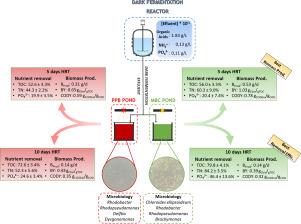A comparative study of the treatment of dark fermentation effluent by purple-phototrophic bacteria and microalgae with focus on substrate to biomass conversion
IF 4.5
2区 生物学
Q1 BIOTECHNOLOGY & APPLIED MICROBIOLOGY
Algal Research-Biomass Biofuels and Bioproducts
Pub Date : 2025-09-19
DOI:10.1016/j.algal.2025.104306
引用次数: 0
Abstract
The treatment of dark fermentation effluents from food waste was evaluated in two photobioreactor systems: a purple phototrophic bacteria (PPB) reactor and a microalgae-bacteria consortium (MBC) reactor. Experiments were performed at hydraulic retention times (HRT) of 5 and 10 days (P1 and P2, respectively) to maximize biomass yield for wastewater valorization.
At the microbiological level, the PPB reactor exhibited a decrease in PPB abundance with longer HRTs, favoring other genera. In contrast, the MBC reactor showed a marked reduction in microalgae under both conditions, with PPBs predominating in P1 and a diverse microbial community in P2. The increase in HRT from 5 to 10 days improved pollutant removal but did not enhance biomass concentration, which stabilized at 0.61 ± 0.08 g/L (PPB) and 1.37 ± 0.16 g/L (MBC) at 5-day HRT.
The highest biomass yield (1.03 ± 0.07 gCbiomass/gTOCremoved) was achieved in the MBC reactor at 5-day HRT, where preferential consumption of lactate and butyrate occurred, leaving acetate less assimilated. Despite the lower overall pollutant removal at 5-day HRT (TOC: 56.0 ± 3.5 %, TN: 60.3 ± 9.0 %, PO₄3−: 20.4 ± 7.4 %), this condition allowed for higher conversions of dissolved carbon into biomass rather than full mineralization. This trade-off is advantageous when targeting biomass valorization over complete pollutant removal, especially considering the commercial value of the residual organic acids. These results highlight the potential of short HRT operations in MBC systems for industrial application, enabling efficient resource recovery from fermentation effluents through selective assimilation, while maximizing biomass productivity and minimizing loss of valuable organics.

紫色光养细菌和微藻处理暗发酵废水的比较研究,重点研究底物向生物质的转化
在两个光生物反应器系统:紫色光营养细菌(PPB)反应器和微藻-细菌联合体(MBC)反应器中对食物垃圾暗发酵废水的处理进行了评价。在水力滞留时间(HRT)为5天和10天(分别为P1和P2)的情况下进行实验,以最大限度地提高废水增值的生物质产量。在微生物水平上,随着hrt的延长,PPB反应器的PPB丰度降低,有利于其他属。相比之下,MBC反应器在两种条件下的微藻均明显减少,P1中以PPBs为主,P2中微生物群落多样。HRT从5天增加到10天,改善了污染物的去除,但没有提高生物量浓度,在HRT 5天稳定在0.61±0.08 g/L (PPB)和1.37±0.16 g/L (MBC)。在5天的HRT条件下,MBC反应器获得了最高的生物质产量(1.03±0.07 gCbiomass/gTOCremoved),其中乳酸和丁酸盐优先消耗,醋酸盐较少被同化。尽管在5天的HRT下,总体污染物去除率较低(TOC: 56.0±3.5%,TN: 60.3±9.0%,po4 3−:20.4±7.4%),但这种条件允许溶解碳更高地转化为生物质,而不是完全矿化。当目标是生物质增值而不是完全去除污染物时,这种权衡是有利的,特别是考虑到残留有机酸的商业价值。这些结果突出了在MBC系统中进行短时间HRT操作的工业应用潜力,通过选择性同化,可以有效地从发酵废水中回收资源,同时最大限度地提高生物质生产力并减少有价值有机物的损失。
本文章由计算机程序翻译,如有差异,请以英文原文为准。
求助全文
约1分钟内获得全文
求助全文
来源期刊

Algal Research-Biomass Biofuels and Bioproducts
BIOTECHNOLOGY & APPLIED MICROBIOLOGY-
CiteScore
9.40
自引率
7.80%
发文量
332
期刊介绍:
Algal Research is an international phycology journal covering all areas of emerging technologies in algae biology, biomass production, cultivation, harvesting, extraction, bioproducts, biorefinery, engineering, and econometrics. Algae is defined to include cyanobacteria, microalgae, and protists and symbionts of interest in biotechnology. The journal publishes original research and reviews for the following scope: algal biology, including but not exclusive to: phylogeny, biodiversity, molecular traits, metabolic regulation, and genetic engineering, algal cultivation, e.g. phototrophic systems, heterotrophic systems, and mixotrophic systems, algal harvesting and extraction systems, biotechnology to convert algal biomass and components into biofuels and bioproducts, e.g., nutraceuticals, pharmaceuticals, animal feed, plastics, etc. algal products and their economic assessment
 求助内容:
求助内容: 应助结果提醒方式:
应助结果提醒方式:


